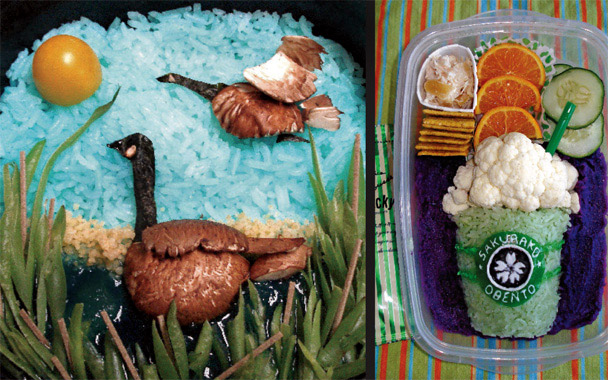Cherry tomatoes and mandarin oranges arranged in symmetrical rows; a bouquet of pink daikon roses; three little pigs with faces made of red sushi rice and ears made of sausage: Such are the joys of bento boxes. The segmented containers—typically filled with a variety of small, artfully crafted bites or ingredients—first came into widespread use in the 1600s in Japan, when travelers and sightseers used them to carry their meals on long journeys and trips to the theater alike. Takeout bento boxes began showing up at Japanese train stations in the 1800s, and although they fell out of vogue in post-WWII Japan, the 1980s saw a resurgence. Japanese restaurants in the U.S. have long offered bento (which translates as “packed lunch”), but now this culinary art form is undergoing a new wave of popularity, with several new cookbooks devoted to bento coming out this year. These books, as well as the legion of blogs that have cropped up in the past three years, show how beautiful (and healthy) bento can be.
Leading the current crop of books is 500 Bento Lunches: 500 Unique Recipes for Brilliant Bento. The book—out this month from the small, virtually unknown British press Korero Books—climbed as high as number two on Amazon’s list of “popular pre-orders” in the cookbook category months before it came out. Its organic, sustainable bento recipes are terrific, but what’s really stunning are the vibrant illustrations of bento. In one, an egg-shaped woman wears a skirt of pink rice (colored with natural food dye) and a scarf fashioned out of crab stick; in another, a shark formed out of tuna salad surges up out of a sea of broccoli. Ian Castello-Cortes, who founded Korero about 18 months ago, said that one of the things that impressed him most about the book was the creativity involved; another was the healthy aspect of bento. “You look at the picture and think, ‘I’d love that for lunch—and I’d feel quite worthy after eating it.’” One of Castello-Cortes’s favorite bento creations features geese flying through reeds—made with scallions, rice, and sugar snap peas. “It’s just beautiful to look at,” he said, “and you almost think, ‘I don’t want to eat that because it looks so great.’”
Good looks also play a large part in two other new bento books. Kentaro Kobayashi, the author of Easy Japanese Cooking: Bento Love (due to be released in August by Vertical, an imprint of Random House), attended art school and works as an illustrator. His mom, cookbook author Katsuyo Kobayashi, is well known in Japan for her show, Today’s Cooking; drawing on these elements of his background, Kentaro’s book features artful images and 60 practical recipes. And The Manga Cookbook, out now, could easily be mistaken for a Japanese comic. Filled with manga illustrations of wide-eyed girls and boys making dishes like “the world’s largest rice ball,” the book is an education, too. “There are a lot of translated manga that feature food that may be strange to people living in North America,” says Glenn Kardy, of Japanime Co. Ltd., the book’s publisher. But while The Manga Cookbook has its roots in comic books, it’s also a real cookbook written by chef and nutritionist Yoko Ishihara, with tips on bento box color schemes and filling up empty space in the box (the latter is key to keeping delicately crafted foods intact). The book is so popular that it’s outselling weighty tomes written by stars of the Japanese TV show Iron Chef (including including Masaharu Morimoto), and the publisher is working on a gift set that will pair the book with a handsome bento box.
Perhaps the most fun aspect of bento, though, is clicking through the wild creations posted online by home cooks. Crystal “Pikko” Watanabe, a 29-year-old Honolulu mom who writes the blog Adventures in Bento Making and contributed to 500 Bento Lunches, posts photos of the lovely bento she creates a few times a week. She says the lure of bento lies in its health benefits and environmental friendliness (since she uses washable, reusable containers). But most of all, she says, it’s therapeutic. “I just [get] enjoyment out of making my food look presentable,” she says.
For more bento, check out the bento Flickr group page (and the Live Journal sites Bentolunch and Eat My Bento.



 Pinterest
Pinterest


